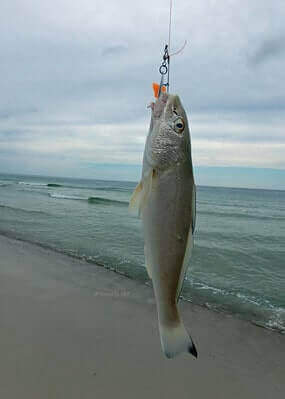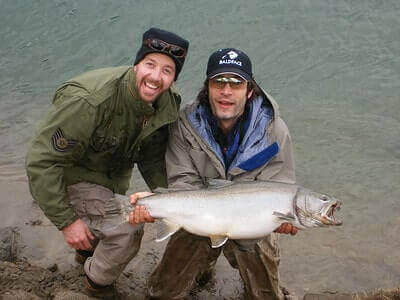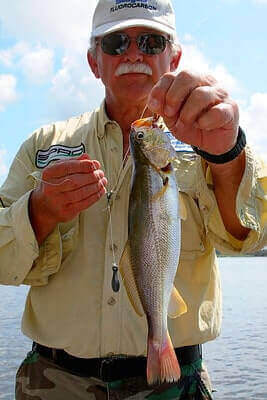Disclosure: We may earn commissions if you purchase products after clicking on a link from our site.
Do you want to learn how to catch sand seatrout? Are you thinking of a new challenge and want to be successful fishing sand seatrout? Sand Seatrout likes to be at the bottom most of the time which can be a challenge for anglers.
In this article, we will discuss how to catch sand seatrout, the rig setup, how to catch sand seatrout from the shore, and sand seatrout fishing tips to catch many.

Table of Contents
How To Catch Sand Seatrout
Sand seatrout spends most of its time at the bottom where it preys on baitfish and shrimps. When you are learning how to catch sand seatrout, use a deep-diving bottom fishing setup with a one or two-ounce sinker and a circle hook.
You want your bait to get as close to the bottom as possible to get the attention of sand seatrout. Sand seatrout can be found as deep as 300 feet. Therefore, a sinker will help get your bait to the bottom.
Similarly, you can use lures, flies, and cut bait when fishing for sand seatrout. Rubber worms and artificial minnows can also be used to catch sand seatrout. Sand seatrout can grow up to three pounds and length of about 2 feet.
1. Bottom Fishing
Bottom fishing is a popular method used to catch sand seatrout, also known as sand trout. Anglers employ this technique by rigging their lines with weights and hooks baited with natural baits such as shrimp, squid, or small baitfish.
The rig is then cast into deeper channels or around structure where sand seatrout are known to congregate. As the bait sinks to the bottom, the angler waits for a bite, indicated by a tap or a sudden movement of the rod tip.
Patience is key in bottom fishing, as sand seatrout tend to feed near the seabed. Once a bite is detected, the angler sets the hook and reels in the catch. Bottom fishing for sand seatrout can be productive in various coastal environments, including estuaries, bays, and channels.
For more information on bottom fishing techniques and regulations, anglers can refer to resources provided by the National Marine Fisheries Service (NMFS): NMFS Fishing Regulations.
2. Drift Fishing
Drift fishing is another effective method employed to target sand seatrout in their natural habitat. Anglers drift along the coastline or over known sandbars and drop-offs while presenting baited rigs to entice these fish.
This technique involves allowing the bait to drift naturally with the current, covering a larger area, and increasing the chances of encountering feeding sand seatrout. Popular baits for drift fishing include live shrimp, mullet, or other small baitfish rigged on a variety of rigs such as Carolina rigs or free-lined setups.
Anglers must pay close attention to their drift speed and direction to ensure optimal presentation of the bait. Drift fishing can be particularly productive during periods of tidal movement or when sand seatrout is actively feeding. To learn more about drift fishing strategies and safety guidelines, anglers can consult resources provided by the National Oceanic and Atmospheric Administration (NOAA): NOAA Fisheries Resources.
3. Jigging
Jigging is a versatile fishing technique commonly used to catch sand seatrout in both shallow and deep waters. Anglers utilize specialized jigs, often adorned with soft plastic bodies or feathers, to mimic the movements of prey species and attract the attention of sand seatrout.
By imparting various rod movements, such as jerks or twitches, anglers can create an enticing action that entices strikes from these predatory fish. Jigging can be effective when targeting sand seatrout around structures such as piers, docks, or submerged vegetation, as well as in open water environments.
Anglers can experiment with different jig colors, and sizes, and retrieve speeds to determine what triggers the most bites from sand seatrout. Proper jigging technique and equipment selection are essential for success when employing this method. For additional guidance on jigging techniques and gear recommendations, anglers can refer to resources provided by the U.S. Fish and Wildlife Service (USFWS): USFWS Angler Resources.
How To Catch Sand Seatrout From Shore
Sand seatrout can be caught from the shore. Sand seatrout like warm waters; therefore, your best chance of catching them is when the waters are warm during the summer. Cut fish and shrimps are the best baits to use when learning how to catch sand seatrout. Bait casting from the shore will be one of the best fishing methods to implement from the shore.
How To Catch Sand Seatrout at Night
Sand seatrout is attracted to light. This knowledge can help you use it to your advantage when fishing for sand seatrout at night. When fishing for sand seatrout at night, you will need a headlamp or bright flashlight to see into the water. This light will also attract sand seatrout as they are attracted to light.
Additionally, use a jig with a cut fish as bait and get it to the bottom. Sand seatrout will get attracted to your rig setup and get them to bite. Bouncing the jig at the bottom can send them into a frenzy. A shiny and light lure will get more attention from sand seatrout at night.

How To Catch Sand Seatrout In Florida
Fishing for sand seatrout is not regulated in the state of Florida. You can catch sand seatrout using the same fishing methods anglers use in other states. They are often found at the bottom. Therefore, your rig setup will need a sinker to get your bait at the bottom where sand seatrout will be located. Cut fish, and shrimps are the major bait anglers use when fishing for seatrout.
Additionally, lures and flies can also be used to catch sand seatrout. Artificial minnows and rubber worms are also used by anglers when fishing for sand seatrout.
Sand Seatrout Tackle Setup
Light to medium action rods will get the job done. Spinning reels or baitcasting reels will work well for sand seatrout fishing. The rig set up for sand seatrout can be a deep-diving, bottom fishing rig with a one-ounce sinker and a circle hook. Setting up 2 or 3 fishing rods will yield more results.
Best Bait For Sand Seatrout
- Shrimp
Shrimp is one of the most effective baits for targeting sand seatrout, also known as sand trout, due to its natural appeal and availability in their coastal habitats. Sand seatrout are voracious predators that readily consume live shrimp when presented properly. Anglers can use live or fresh dead shrimp rigged on a variety of rigs, including Carolina rigs, free-lined setups, or jig heads, to entice these fish.
Live shrimp are particularly enticing as they emit enticing scents and exhibit natural movements that attract sand seatrout. Anglers can fish shrimp near the bottom in deeper channels, along drop-offs, or around structure where sand seatrout are known to congregate. When fishing with live shrimp, it’s essential to keep them lively by hooking them securely through the body or tail to ensure they appear natural and enticing to hungry sand seatrout.
Additionally, anglers can enhance the effectiveness of shrimp baits by adding scent attractants or using brightly colored floats to increase visibility in murky waters. Overall, shrimp is a versatile and reliable bait option for sand seatrout fishing, offering anglers a high probability of success when properly presented. For more information on using shrimp as bait for sand seatrout fishing, anglers can consult resources provided by the National Oceanic and Atmospheric Administration (NOAA): NOAA Fisheries – Shrimp Bait Tips.
2. Cut Fish
Cut fish, such as mullet, croaker, or menhaden, can be an effective bait choice for targeting sand seatrout, also known as sand trout, along coastal shorelines, and in estuarine environments. The scent and oils released from cut fish can attract sand seatrout from a distance, enticing them to strike.
Anglers typically cut the fish into chunks or strips, exposing the flesh and allowing the scent to disperse into the water. Rigging the cut fish on a variety of setups, including Carolina rigs, fish finder rigs, or even free-lined presentations, can effectively entice sand seatrout.
The key to success when using cut fish as bait for sand seatrout is to ensure that the bait remains fresh and retains its natural scent. Anglers can fish cut fish near the bottom in areas with sandy or muddy bottoms, along drop-offs, or near structures where sand seatrout are known to feed.
Additionally, incorporating natural movements into the presentation by allowing the cut fish to drift or bounce along the bottom can further enhance its effectiveness. Overall, cut fish can be a productive bait option for targeting sand seatrout, offering anglers a reliable method for enticing these prized inshore species. For more information on using cut fish as bait for sand seatrout fishing, anglers can consult resources provided by the National Oceanic and Atmospheric Administration (NOAA): NOAA Fisheries – Bait Tips.

Best Lures For Sand Seatrout
- Artificial Minnows
Artificial minnows, also known as soft plastic swimbaits or imitation minnow lures, are popular and effective options for targeting sand seatrout, especially in shallow coastal waters and estuaries. These lures closely mimic the appearance and swimming action of natural baitfish, making them irresistible to sand seatrout.
Designed with lifelike details, including realistic body shapes, fins, and eyes, artificial minnow lures create a convincing presentation that entices strikes from hungry fish. Anglers can choose from a variety of sizes, colors, and styles to match the local baitfish species and water conditions. Rigging artificial minnows on jig heads or weighted hooks allows for precise control over the lure’s depth and action, making it versatile for different fishing scenarios.
Whether retrieved with a steady retrieve, a stop-and-go retrieve, or a twitching motion, artificial minnow lures effectively imitate the movements of fleeing baitfish, triggering aggressive strikes from sand seatrout. Anglers can experiment with different retrieval speeds and techniques to determine the most productive presentation on any given day.
Overall, artificial minnow lures are valuable tools in the angler’s arsenal for targeting sand seatrout, providing versatility, realism, and consistent performance. For more information on using artificial minnows as lures for sand seatrout fishing, anglers can consult resources provided by the National Oceanic and Atmospheric Administration (NOAA): NOAA Fisheries – Artificial Lures.
2. Rubber Worms
Rubber worms, also known as soft plastic worms or plastic grubs, are versatile and effective lures for targeting sand seatrout in various fishing environments. These lures are designed to mimic the appearance and movement of natural prey, such as small baitfish, shrimp, or aquatic invertebrates, making them attractive to hungry sand seatrout.
Available in a wide range of sizes, colors, and styles, rubber worms can be rigged on weighted hooks or jig heads to achieve the desired depth and action. Anglers often rig rubber worms Texas or Carolina style, allowing for weedless presentations in areas with dense vegetation or structure. The soft, supple texture of rubber worms provides a lifelike feel that encourages fish to hold onto the lure longer, increasing hookup rates.
Additionally, rubber worms can be rigged with scent attractants or added attractor beads to enhance their appeal to sand seatrout. When retrieved with a slow, twitching motion or a steady retrieve, rubber worms produce enticing vibrations and movements that trigger strikes from opportunistic sand seatrout.
Anglers can experiment with different colors and sizes to match the local forage and water conditions, increasing their chances of success. Overall, rubber worms are valuable additions to an angler’s tackle box for targeting sand seatrout, offering versatility, realism, and proven effectiveness.
3. Jigs
Jigs are highly effective lures for targeting sand seatrout in a variety of fishing environments, including shallow flats, channels, and estuaries. These versatile lures consist of a weighted head with a hook, often adorned with a soft plastic or silicone skirt or grub tail to mimic the appearance of baitfish or shrimp.
Anglers can choose from a wide range of jig weights, colors, and styles to match the prevailing water conditions and the preferences of the fish. Lighter jigs are ideal for shallow-water presentations, while heavier jigs are suitable for deeper water or areas with strong currents. Jigs can be retrieved with a slow, bouncing motion along the bottom to mimic the natural movements of forage species, enticing strikes from hungry sand seatrout.
Additionally, anglers can employ a jigging technique by lifting and dropping the rod tip to create erratic movements that trigger aggressive strikes. Jigs can be rigged with additional attractants such as scent or baitfish imitations to enhance their effectiveness further.
When targeting sand seatrout, anglers should focus on areas with submerged structures, drop-offs, or current seams where fish are likely to congregate. By varying the retrieve speed, depth, and presentation style, anglers can experiment with different jigging techniques to entice strikes from sand seatrout in a variety of conditions.
4. Spoons
Spoons are popular lures among anglers targeting sand seatrout, offering versatility and effectiveness in a variety of fishing scenarios. These lures feature a concave, metal body with a reflective finish that mimics the appearance of baitfish, making them highly attractive to predatory species like sand seatrout.
Anglers can choose from a range of spoon sizes and styles, with larger spoons typically used for targeting larger fish in deeper waters and smaller spoons preferred for shallower areas or when targeting smaller fish. The action of a spoon is created by the angler’s retrieve, with variations in speed and rhythm imparting different actions to the lure.
A steady, consistent retrieve can simulate the swimming motion of a baitfish, while occasional pauses or jerks can mimic wounded prey, enticing strikes from hungry sand seatrout. Spoons can be cast and retrieved across sandy flats, along drop-offs, or near submerged structures where sand seatrout are known to feed.
Additionally, anglers can experiment with different colors and finishes to match prevailing water conditions and the preferences of the fish. By adjusting the retrieve speed, depth, and presentation style, anglers can effectively use spoons to target sand seatrout in a variety of environments.
5. Plugs
Plugs are highly effective lures for targeting sand seatrout, offering anglers versatility and the ability to cover a wide range of fishing conditions. These lures typically feature a hard, plastic body designed to imitate baitfish or other prey species, with realistic colors and finishes to attract the attention of predatory fish like sand seatrout.
Plugs come in various shapes and sizes, allowing anglers to match the hatch and mimic the natural forage in the area where they are fishing. Floating plugs are ideal for fishing shallow flats and around submerged vegetation, while sinking or suspending plugs are better suited for targeting deeper waters or when fish are holding at different depths.
The action of a plug is created by the angler’s retrieve, with a variety of techniques including steady retrieves, erratic jerks, or pauses to mimic injured baitfish and trigger strikes from sand seatrout. Anglers can also experiment with different speeds and cadences to determine what triggers the most strikes under current conditions.
Plugs can be cast and retrieved along shorelines, worked around structures such as docks or jetties, and even trolled behind a boat to cover large areas of water. By adjusting the presentation and lure selection based on prevailing conditions and the behavior of the fish, anglers can effectively use plugs to target sand seatrout in a variety of environments.
For more information on using plugs as lures for sand seatrout fishing, anglers can consult resources provided by the National Oceanic and Atmospheric Administration (NOAA): NOAA Fisheries – Using Plugs for Saltwater Fishing.

Sand Seatrout Fishing Tips
- Sand seatrout likes shrimp and small fish. This makes cut fish, live bait, flies, and lures great for catching them.
2. Rubber worms and artificial minnows work well as lures for catching sand seatrout.
3. The spawning season for the sand seatrout happens in summer and spring.
4. Sand seatrout is most active during the summer months when the water is warm; they like warm water.
5. Sand seatrout can be found in canals, river channels, bays, artificial reefs, piers, and flats 11 feet or deeper.

6. Sand seatrout is attracted to light.
7. If you will not prepare and eat it the same day, then it is better to put sand seatrout on ice in a cooler.
8. The best time of the day to go sand seatrout fishing is mid-late morning and late afternoon. During this time the water is warmer and baitfish and insects are more active.
9. Sand seatrout is different from the silver seatrout. Sand Seatrout has 12 rays on its bottom fins while silver trout has 9.
10. A parasite, the spaghetti worm, lives inside it. However, it is still good to eat and you can prepare it and eat it without getting infected with the parasite. The sooner you prepare it, the better. It can be grilled, fried, baked, or cooked.
The Bottom Line
Sand seatrout, also referred to as the white trout or sand trout can be found in parts of the Atlantic Ocean and the Gulf of Mexico. It is often found in deep waters about 300 feet and at the bottom where they prey on shrimps and other small fish.
Sand seatrout can be caught using cut bait and shrimps. Bait casting and vertical jigging are some of the fishing methods that anglers use when fishing for sand seatrout. In this article, we have discussed the fishing methods, and fishing tackle setup, as well as shared fishing tips to improve your chances of catching a lot of sand seatrout.
If you also fish for spotted seatrout, Artic Char, and weakfish, you can read how to catch spotted seatrout, how to catch Artic Char, and weakfish fishing tips.